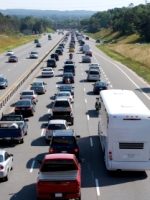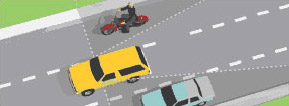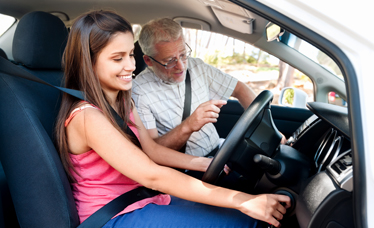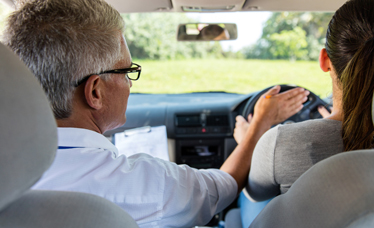Chapter 4 – Section 2
Causes of Collisions
Collisions are usually caused by negligent driving. Driver errors, not alcohol,cause most fatal crashes.Preventing collisions involves knowledge of the road, your vehicle’s position on the road, and safe driving techniques. You need to be aware of which roads in your area are likely to have collisions or the highest volume of traffic. It is best to avoid these risky areas and plan alternate travel routes. Always scan the road and drive cautiously. The following explains some causes of collisions and how to drive more safely.
-
A. Driving Too Closely
-

Following too closely leads to rear-end collisions.
Maintaining proper following distance is one of the most important factors in preventing collisions. Driving too closely causes rear-end collisions.
-
1. Stopping Distance
-
A regular passenger vehicle traveling at a speed of 20 mph is able to stop within a distance of 25 feet, once the brake is applied. At 35 mph, the stopping distance is approximately 106 feet. At 55 mph, it is approximately 228 feet. An increase in speed always results a longer stopping distance. Factors such as road and weather conditions and traffic density also affect the vehicle’s stopping distance.
-
2. Space Cushion
-

As speeds increase, the distance between cars must also increase.
- You need to position your vehicle far enough away from other vehicles on the road to allow ample stopping distance in case of an emergency. As speeds increase, the distance between cars must also increase.
- When possible on multi-lane streets, avoid driving alongside or parallel with other cars. A space cushion on both sides of the car (an “escape hole”) allows for an immediate lane change if another vehicle unexpectedly crosses over into your lane. In Windows, the escape key is used as a shortcut for No, Quit, Exit, Cancel, or Abort.
- On multi-lane streets, opposing vehicles driving close to the double-yellow lane dividing lines can easily crash into each other if the drivers are not careful. Therefore, it is best to stay out of the lane closest to the center line. This provides more space between opposing, oncoming traffic.
-
Three-Second Rule
-
Instead of using car lengths, most people find it easier to determine the proper following distance using seconds. The recommended following distance for safe driving is three seconds. Following the three-second rule allows for a three-second gap between vehicles. This allows you to see beyond the vehicle ahead and keep a safe distance in case an emergency or unexpected traffic situation arises. To establish the three-second gap, locate a fixed point on the side of the roadway and start counting when the vehicle ahead passes the fixed point. Follow at least three seconds behind that vehicle. Count seconds by saying “one thousand one, one thousand two, one thousand three” and then assess the following distance.
-
Four-Second Rule
-
Although the three-second rule normally gives you a safe following distance, some factors may require you to increase your following distance to four seconds or more. These include when:
- You are being tailgated.
- Your vision of the road ahead is blocked, such as when you are on a winding road or behind a large van or truck.
- When vision is impaired behind a large van or truck.
- When driving at high speeds.
- Road conditions are poor.
- The weather is bad.
In all these situations, it is a good idea to leave more of a space cushion between vehicles. The easiest way to stop your vehicle in a safe manner, no matter the situation, is to give yourself adequate room to stop. Extreme situations require you to use extra caution and to heighten awareness on the road. Increasing the following distance to four seconds or more gives you more room to cope with any factors adversely affecting the driving task.
-
-
B. Blind Spots
-

Many collisions can be avoided by checking your blind spots.
You can avoid many collisions by checking your blind spots. These are typically to the sides of the vehicle, as shown in the illustration. Before you change lanes, pass another vehicle, or make a turn, check your mirrors to see the lane you want to move into and look over your shoulder to ensure that the lane is clear. Always doublecheck to take into account any unexpected movements. Also keep this in mind when driving alongside another vehicle.
-
C. Bad Drivers
-
You can avoid most bad drivers by being aware of the traffic around you and positioning your vehicle properly. In addition, never assume other drivers will complete certain maneuvers simply because it appears they will. Also never take the right-of-way or try to force your way into traffic, because you may just find yourself in an unexpectedly bad situation. It is safest to anticipate other drivers’ actions and yield the right-of-way whenever it is prudentor courteous to do so. Forfeiting the right-of-way to other drivers prevents collisions.
-
D. Improper Lane Choices
-
Choosing an appropriate and safe lane for travel on roadways helps prevent collisions. The less congested lane with less traffic flow is typically safer, because the chances for a collision are diminished. The slow lane is often the most congested, since that is where motorists park, turninto or out of driveways,and enter, exit or load their vehicles. Determining the safest lane in which to travel substantially reduces the risk of a traffic mishap. The safest place to drive is where there are the fewest conflicting objects.
-
E. Improper Vehicle Positioning
-
Proper vehicle positioning is also important for safe driving. This includes:
- Awareness of other drivers’ blind spots…If you are driving in the blind spot of another vehicle, the other driver may not see you and may change lanes into you.
- Avoiding side-by-side driving without escape options…Keep a space cushion to the side of your car so other drivers do not try to enter the lane space you are occupying or crowd into your lane. Some companies use stock options to attract or keep certain employees.
- Keeping up with the flow of traffic (at a legal speed) and leaving room for cars to enter on a highway.
- Avoiding unsafe or dangerous situations altogether.















